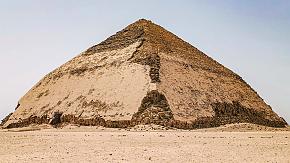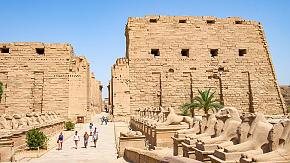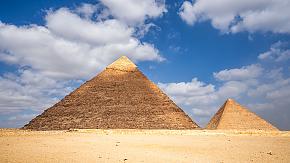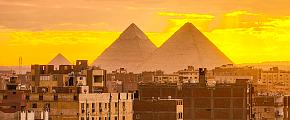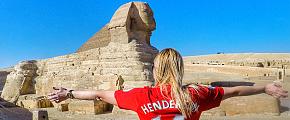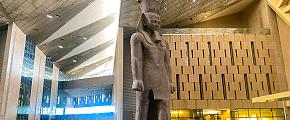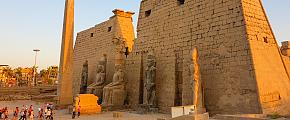All You Need to Know About the Karnak Temple
The Karnak Temple is the largest temple complex in Egypt, covering an area of more than 200 acres and with a history of more than 4000 years. Located on the east bank of the Nile River, the ancient temple complex was dedicated to the god Amun, the god of sun and air, the god Mut, the mother goddess, and the god Montu, the god of the moon. The precinct of god Amun is the most prominent in Karnak, particularly the Great Hypostyle Hall, which is made up of 134 columns with the highest reaching 70 feet. The Karnak Temple was designated a UNESCO World Heritage site in 1979. The Karnak Temple is one of the most popular sites in Luxor, if you take a tour to Egypt, the Karnak Temple could be on your bucket list. With this article, you'll learn more about it, let's check it out!
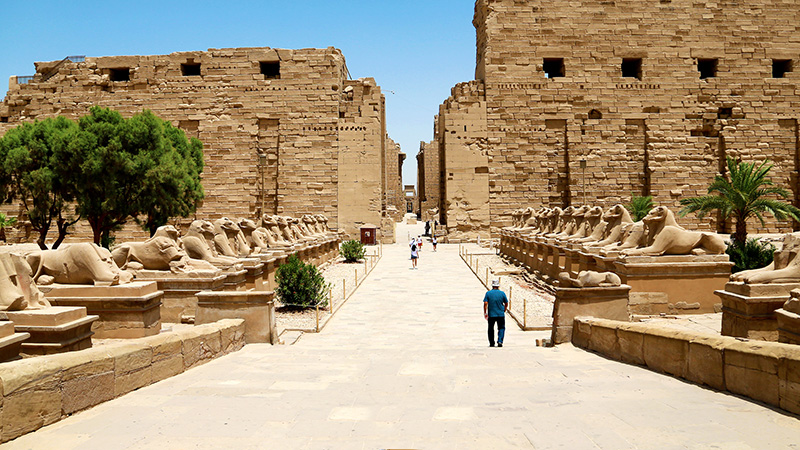 The Karnak Temple
The Karnak Temple
What is Karnak Temple?
Ancient Egyptians believe in various gods and goddesses. Pharaohs and kings of ancient Egypt built many temples to worship their gods and made offerings and sacrifices to them. The Karnak Temple, serving this religious purpose in ancient Egypt, was dedicated to the god Amun, the god of sun and air. The other two deities worshiped there are Amun's wife, god Mut, the mother goddess, and their son, god Montu, the god of the moon. One thing worth mentioning is that the temple is not a place for praying, but rather a mansion for gods to live in.
In Arabic, "Karnak" means "fortified village"; the Karnak Temple is like a village, consisting of a number of temples, chapels, and other buildings. It is the largest temple complex in Egypt, covering an area of more than 200 acres.
Where is Karnak Temple?
The Karnak Temple is located in the Luxor Governorate of southern Egypt, on the east side of the Nile River bank.
It is about 410 miles driving distance from Cairo and around 250 miles from Aswan; only 15 minutes drive from Luxor's International Airport.
Brief History of Karnak Temple
The Karnak Temple boasts a history of more than 4000 years. It was built gradually over the centuries, from the beginning of the Middle Kingdom (2040 - 1782 BC) to the New Kingdom (1570-1069 BC) and throughout the Ptolemaic Dynasty (323 - 30 BC).
The first monument thought to be raised at the site was by Wahankh Intef II (c. 2112–2063 BC), who erected a column to honor the god Amun. But this claim has been argued by scholars who believed that it had been built in the Old Kingdom. The first known temple at the Karnak site was built by King Senusret I (c. 1971 - 1926 BC) of the Middle Kingdom.
When coming to the New Kingdom (1570 - 1069 BC), the importance of the temple complex was raised to a new height. It was the center of the ancient religion, while political and military power was also concentrated at Thebes (modern-day Luxor). It also served as a treasury, administrative center, and palace for the pharaohs of this period. The main temple dedicated to God Amun was built in the 18th dynasty. Famous pharaohs such as Seti I, and Rames II have all contributed to the complex during their reigns.
In the 4th century BC, ruler Nectanebo I (380 – 362 BC) added an obelisk, a pylon (unfinished), and a wall to the site, while the wall was to protect the temple from military forays. The last known significant structural addition was by Ptolemy IV, who added an underground chamber in dedication to Osiris by the late 3rd century BC.
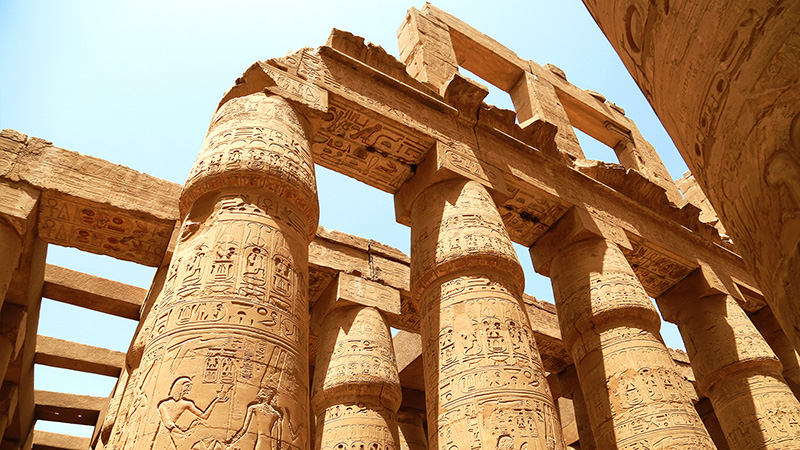 The Karnak Temple
The Karnak Temple
Layout and Highlights of Karnak Temple
The Karnak is divided into three compounds: the precinct of Amun, Mut and Montu. Each precinct contains the main temple, smaller temples, and chapels. The precinct of Amun is the largest and in the center; Mut's precinct is the second largest and in the south; while Montu's precinct is the smallest and in the north.
The Great Hypostyle Hall
In Amun's precinct, the most magnificent building is the Great Hypostyle Hall. It was constructed by King Seti I, who ruled from 1290 to 1279 BC. The hall is about 337 feet by 170 feet, with 134 columns in total; the largest 12 pillars are 70 feet high, supporting the central part of the structure. The other 122 are about 40 feet tall. The contrast in height between the central and lateral columns allowed for huge stone windows, which were the only source of light. The kings of Thebes had their coronations in this room.
Ram-Head Sphinx-Lined Road
There is a ram-head sphinx-lined road leading to the precinct of Amun. As the ram is one of the animals associated with the god Amun, those sphinxes served as guardians of the procession routes. Ordinary Egyptians are not allowed to enter the sacred precinct, so they had to rely on symbolic intermediaries to communicate their wishes to the gods. That is another task for those sphinxes.
The Obelisks
In the precinct of Amun, there are three giant obelisks: King Seti II Obelisk, Thutmose I Obelisk, and Queen Hatshepsut Obelisk. Queen Hatshepsut Obelisk is the highest in ancient and modern Egypt, which is 95 feet high with 323 tons. There is one line of an inscription at the center of the shaft, and the coronation name is engraved at the lower portion of the east side. On both sides of the central inscription, the illustration of Queen Hatshepsut and her son Thutmose III is engraved. This is unique as an illustration of the obelisk.
Sacred Lake
On the southeast of Amun's temple lies the Sacred Lake of this precinct. It covers 100,000 square feet. According to archaeologists, ancient Egyptians used the lake for purification rituals and the priests' daily ritual baths. Scholars also discovered the remains of the priests' houses near the Sacred Lake.
Temple of Mut
Temple of Mut is the largest in the precinct of Mut. This temple is known for the black granite statues of Sekhmet placed by Amenhotep III. Scholars believe that he may have dedicated 700 of these statues. Another two temples in this precinct are well preserved. One of them was built by Ramesses III who had it decorated with military scenes detailed with his campaigns.
Khonsu Temple in the Precinct of Montu
Khonsu temple is dedicated to Amun and Mut's son, Montu. It is in the South-west corner of Amun's precinct, relatively small but staying intact. A gate leads through the enclosure wall and links with Mut's temple. From the roof of this building, there is a good view of the Karnak Temple.
Karnak's Pylons
At Kanak, a series of 10 pylons were built, functioning as gateways of sorts. They start near the main sanctuary and lead in two directions. One set of six pylons faces west, towards the Nile River, and ends at the entrance of the Sphinxes-Lined Road. The other set of four pylons faces south along a processional route used for ceremonies. They were connected to each other through a network of walls. The Pylons were often decorated with scenes depicting the rulers who built them.
 The Karnak Temple
The Karnak Temple
Restoration of Karnak Temple
Though today's visitors may find the Karnak Temple stunningly magnificent, most parts of it remain a jumble of ruins. Important restoration work was done to the Great Hypostyle Hall in 1899. Giant pillars were re-erected back to their foundations, and the stone roof was also restored.
Recent work in this hall includes the restoration of the giant pillars in the form of an open papyrus flower as the first stage, then the rest pillars as the second stage. Work also involves removing dust and treating the effects of erosion factors on 134 columns, in addition to restoring the decorations and hieroglyphic writings.
Another recent restoration is to the carving and inscriptions of the Temple of Khonsu, one of the best preserved and almost complete of the New Kingdom temples.
Visiting Tips
Entry Pass
Entry pass costs 150 EGP (around 10 USD) per person.
A Guide is Recommended
As Karnak is a famous historical site in Luxor, it is recommended to hire a guide, who will show you the most important parts and explain the stories behind each splendid scene.
Sound and Light Show
Karnak Temple's Sound and Light Show tells secrets about the temple's ancient name, Thebes, and significant monuments. It plays two shows nightly with the first show always in English and the second in either German, Italian, French, or Spanish depending on the day. Ticket for the show costs about 15 USD per adult, and 8 USD per kid aged 6-12.
Open Hours and Rush Hours
The Open hours for Karnak are 06:00-16:30. The busy hours last from 10 am to 3 pm. It is suggested to avoid the rush hours for a better visiting experience.
Duration of Visit
It will cost around 2-3 hours to visit the Karnak Temple complex.
Other Tips
1. Bring water and avoid carrying any alcoholic drinks.
2. Bring a sun shield to protect your skin from the burning sunshine on hot days.
3. Dress properly.
If you're planning to travel to Egypt and explore more amazing heritages, please don't hesitate to contact us, just simply tell us your interests and needs, and one of our travel experts will create a tailor-made itinerary for you within 24hrs.
What Our Clients Say
Explore the latest verified reviews of Odynovo's travel services on Tripadvisor, Google, Trustpilot, Product Review and more trusted platforms.

